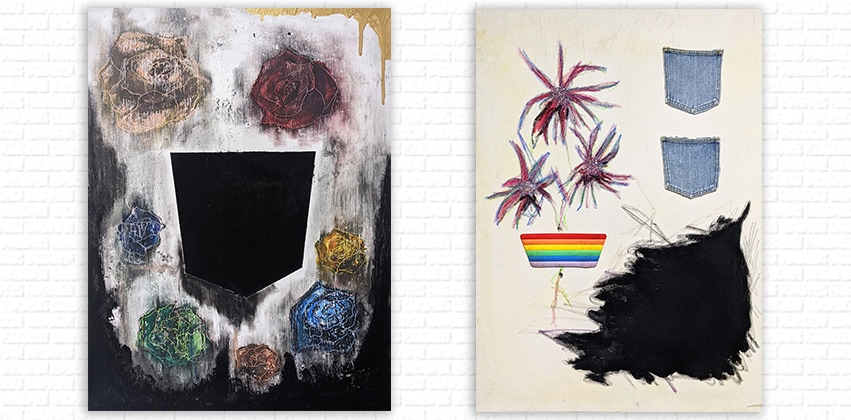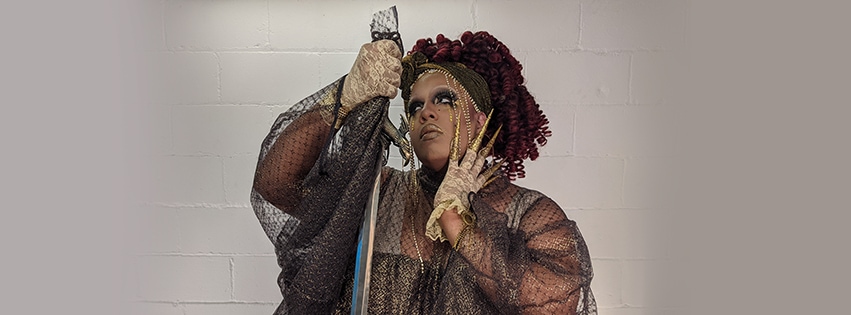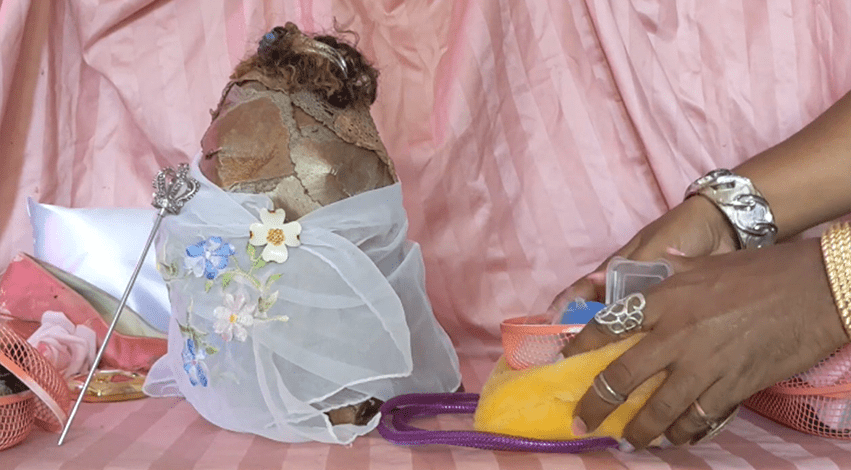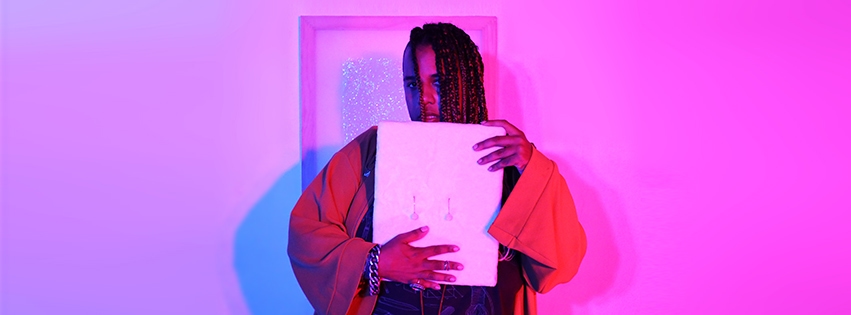There is only one Alexander Martin, but endless facets to their personality. Art, community, service, performance, outreach and design—all this and more shapes the individual whose life exemplifies what it means to be thoughtful, insightful and creative, while also challenging norms and promoting growth. As a Black, multiracial and queer artist living in Peoria, Martin invites others to explore the many ways in which we express our own identity—and how we relate to others whose identity and experience stand in stark contrast to our own. At the center of it all, one word brings everything together: empathy.
Sense of Place
Growing up in the small city of Hurricane, West Virginia, Alexander Martin always wanted a career in the arts. Initially they thought this would mean pursuing graphic design, but when Martin took a screen printing class at West Virginia University, they discovered a passion for studio work. They began to pair text with mundane objects, exploring the meanings that could be conveyed in a pared-down, straightforward manner. But by embracing the crisp, clean aesthetic of contemporary art as defined by academia, Martin was denying a part of themselves that was fundamentally… well, messy.
“I was a little tainted by the academic system,” Martin explains with a chuckle. “I wasn’t saying everything I needed to say with my work.”
During their final year of the BFA program in West Virginia, Martin visited Chicago to see a friend’s exhibit—a fateful trip that would forever alter the course of their life. “Chicago was so different, and Illinois was a different world,” they recall enthusiastically. Quickly falling in love with this slice of the Midwest, Martin soon applied and was accepted into the MFA program at Bradley University in Peoria.
The move came at a time when Martin was increasingly struggling with questions about their gender identity. This is reflected in work produced during that time, if indirectly. “I think I was afraid to put in my own stories, my own personality,” Martin observes. They began using packaging and containers in their work, creating cardboard sculptures and filling them with various materials. In many ways, these sculptures represented Martin’s explorations with masculinity and femininity—and a growing understanding of their identity as a non-binary trans person.
“I was embracing that aspect of myself… things that I had repressed for so long. It was coming out in the work. There were these big, brown boxes with pink ooze coming out—glitter, sequins, foam, all kinds of stuff,” Martin recalls. “And that was like me!”

While in graduate school, Martin teamed up with fellow MFA student Jessica Bingham and her husband Zach Ott to launch Project 1612—an independent artist space and micro-residency in Peoria, entirely funded through crowdsourcing. “It changed my life,” Martin declares. “It made me realize the power of community involvement… like-aligned people working to bring something together.” That sense of commitment to improving their community grew quickly, and they soon became involved with other local nonprofit groups, including the Renaissance Park Community Association, Peoria Proud and Central Illinois Friends.
After graduating from Bradley in 2017, Martin took up artist residencies both locally at the Prairie Center of the Arts in Peoria, and internationally at Tottenham Hale International Studios in London—in addition to being featured in a slew of exhibitions across the United States. The muted browns of the packaging materials used in their MFA sculptures were changing, replaced by bright, vibrant pastels. Here again, Martin’s artwork reflected their own personal transformation. “Things that were inside [the box] now made it to the surface,” they explain. “It’s like I was doing the same thing… My outside was reflecting my internal identify more.”
Around this time, Martin began to incorporate a new form of performance art in their life: drag. They took the stage name “Artemisia Van Ho”—a reference to Artemisia Gentileschi, an Italian Baroque painter and revered feminist icon, and artist Vincent Van Gogh. Martin’s talents were immediately obvious, and Artemisia Van Ho quickly became the recipient of drag awards as both Miss Gay Peoria and Miss Gay Illinois. Drag became an extension of their artwork and how they approached life, educating people through community events like the Drag Queen Story Hour at Lit. on Fire Used Books, holding fundraisers and more. But despite all their success, Martin was nearing burnout—and devastating news was just around the corner.
Flood of Creativity
In 2019, Martin was working as an adjunct professor and barista, struggling financially and trying to find time for their art and volunteer work. “I was just feeling lost,” they recall. One day, unexpected and tragic news arrived from back home in West Virginia: Martin’s younger sister had passed away. In that moment, everything changed. “When a loss like that happens, you just see things with so much clarity,” they divulge. “I don’t know if it’s shock or grief, but everything sort of made sense… I needed to prioritize things that brought me joy.” For Martin, that applied not only to their career, but to their art as well.
Upon their return to Peoria, Martin left the barista job and eventually started working for Central Illinois Friends. As an outreach specialist and marketing professional, Martin handles design work and assists the nonprofit in its efforts to support individuals in the community who are living with HIV. They also discovered that their work experience now informs their artwork.

“All of the nonprofits I’m involved with line up with who I am as an artist,” Martin points out. “Being an artist isn’t just making work—it’s how you live your life. All the nonprofits I’m involved with are parts of my lived experience. I can put them into my work and share that part of our community.”
With a career in place that was more attuned to their values, Martin was also in need of creative inspiration. When the global pandemic struck in 2020, suddenly there was time and space to sit, think, grieve—and start making new work again. Unlike their graduate school years, however, Martin felt free to focus on the things that meant the most to them. “And it was like a floodgate opened,” they offer with a laugh. “The new work just feels a lot more honest. I’m not performing in the things I make. I am making them because they need to be made… I get joy from making, showing, and getting to have conversations about them.”
Rather than focusing on a traditional series or collection centered around a single concept, Martin’s work exudes a sense of play and exploration. “I am bringing in elements of everything I’ve done before,” they explain, “but also trying to put in more of myself.” This direction is particularly evident in one of their latest works, entitled “You have to steep in it a little to let it out.” Created as the cold days of winter were beginning to turn to spring, the piece references hope, identity and death. On the corner of the canvas, a black mass—one that appears more substantial than simply a void—exists in stark contrast to the soft fabric of blue denim and the colorful flowers and rainbow nearby.
“During the pandemic, I think—like many of us—I was thinking about mortality,” Martin says. They were also still grieving the loss of their sister, and the quiet days allowed time to sit with those feelings of loss and death. That is what the black mass represents—almost threatening, yet filled with purpose. “When stuff gets sucked into a black hole, we view it as nothingness, but it’s actually filled. There is so much—a universe worth of material in that void space!”
Martin is also embracing play as part of the creative process in their recent work. In a prerecorded video and accompanying interactive sculpture created for an exhibition in Florida, “Make UP!” is all about glamour, nostalgia, fashion and dressing up. By creating a sculpture that could be played with, Martin invites people to step back into the experience of childhood. “The sculpture is me—a lumpy, little potato sculpture,” they offer with a laugh. “Visitors were invited to dress up the sculpture however they wanted.”
In many ways, “Make UP!” grapples with the reality that navigating one’s identity can be dangerous—especially as a nonbinary, trans, Black and multiracial person. “It is not safe, but wouldn’t it be great if it could be?” Martin muses. With this sculptural installation, everyone is allowed to explore their identity safely.
The piece was also inspired by the television show Sailor Moon, which Martin grew up watching. In the Japanese version, the title character and her fellow Sailor Guardians would shout “Make up!” before transforming with superhero powers. “I love the drama—the hair, the jewelry, the gloves. And so I was like, ‘I want to make something that can transform!’” Martin recalls. And just as with Sailor Moon, Martin is able to transform every day—whether by exploring new forms of art, contributing to the community or taking on a drag persona—and hopes others would be inspired to do the same by interacting with the sculpture. “We have the power to change ourselves,” they declare. “I wanted to make a piece that captures that moment.”
In 2021, Martin continues to explore artwork that embodies their lived experience. After a year of so much strife, it seems timely and important to pay attention to the messages they are sharing. “Being alive can be difficult. The more systematic issues you add… the harder it can be to exist,” they explain. Their new artistic direction is also a clean break from where they started all those years ago in West Virginia. “This was the nail in the coffin on my academic ideologies!” Martin says with a bright laugh.

Community and Art Aligned
In addition to Martin’s new work, they have also taken on new roles with local nonprofits and arts organizations. As a board member of ArtsPartners of Central Illinois, Martin chairs the Sky Art Peoria committee, which places the work of local artists on Adams Outdoor 48’ x 14’ billboards, amounting to over $36,000 of free advertising to each winning artist. They also expect the return of Project 1612, which has been on hiatus due to the pandemic.
Another significant part of Martin’s life involves working to establish the Peoria Guild of Black Artists (PGOBA) as a nonprofit organization. Formed in 2020, PGOBA is a group of Black creatives who uplift, advocate and provide a platform for Black artists in the community. This summer, the group will be exhibiting work at University Galleries of Illinois State University. “It’s been a dream of mine to show in that space, so it’s still kind of unreal that it’s happening,” Martin adds. PGOBA is also working with Ameren Illinois to bring murals about energy efficiency and sustainability to Black businesses and neighborhoods this year.
Ultimately, Martin sees art as a critical part of undoing the damage done by the festering issues of racism, misogyny and class discrimination. “I think a huge component of liberating everyone is empathy,” they observe. “I feel like through my practice, I can invite someone to have a conversation where it’s not accusatory. I’m not going to attack them.”
Without judgment, and by having fun with their work, they create a space where others can safely ask questions. “I think it lets them get insights and see some of themselves in it,” Martin explains. “That’s why empathy is so important—because you can’t know what someone else goes through… I feel like this work can be the beginning of a conversation to get out of the need to be right and know everything. Because we don’t.
“When you let that go,” they continue, “it gets so much easier to understand and resonate with other folks’ experiences.”PM
To learn more about Alexander Martin and their body of work, visit alexanderandrewmartin.com.




